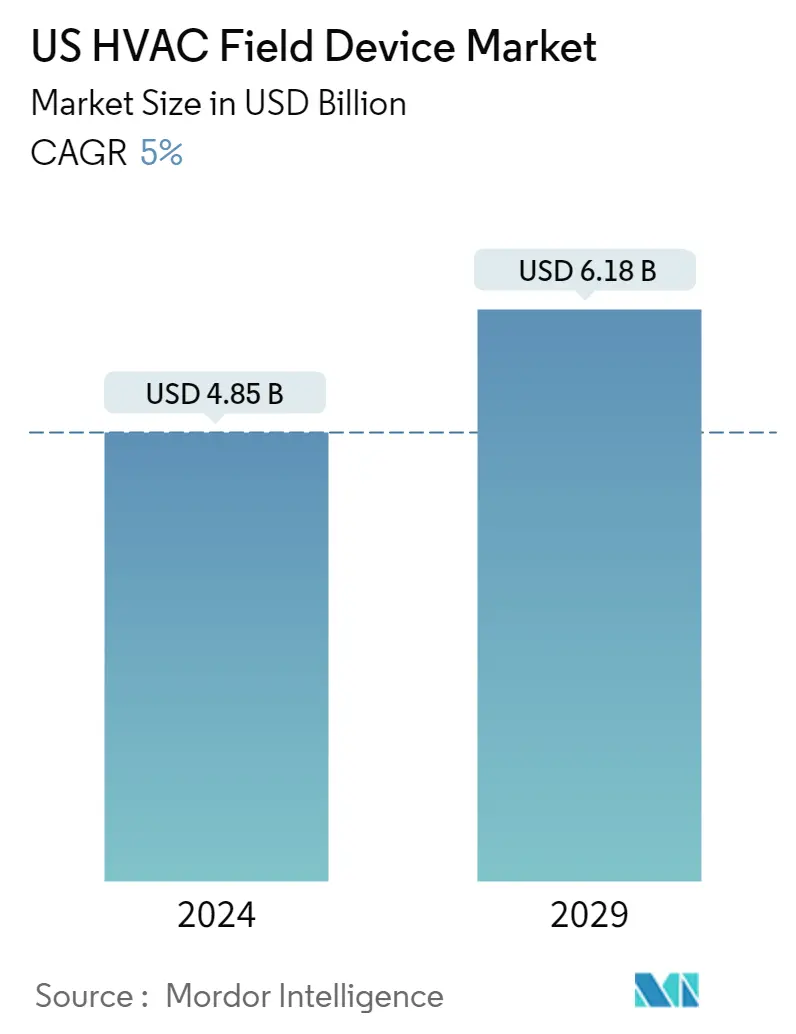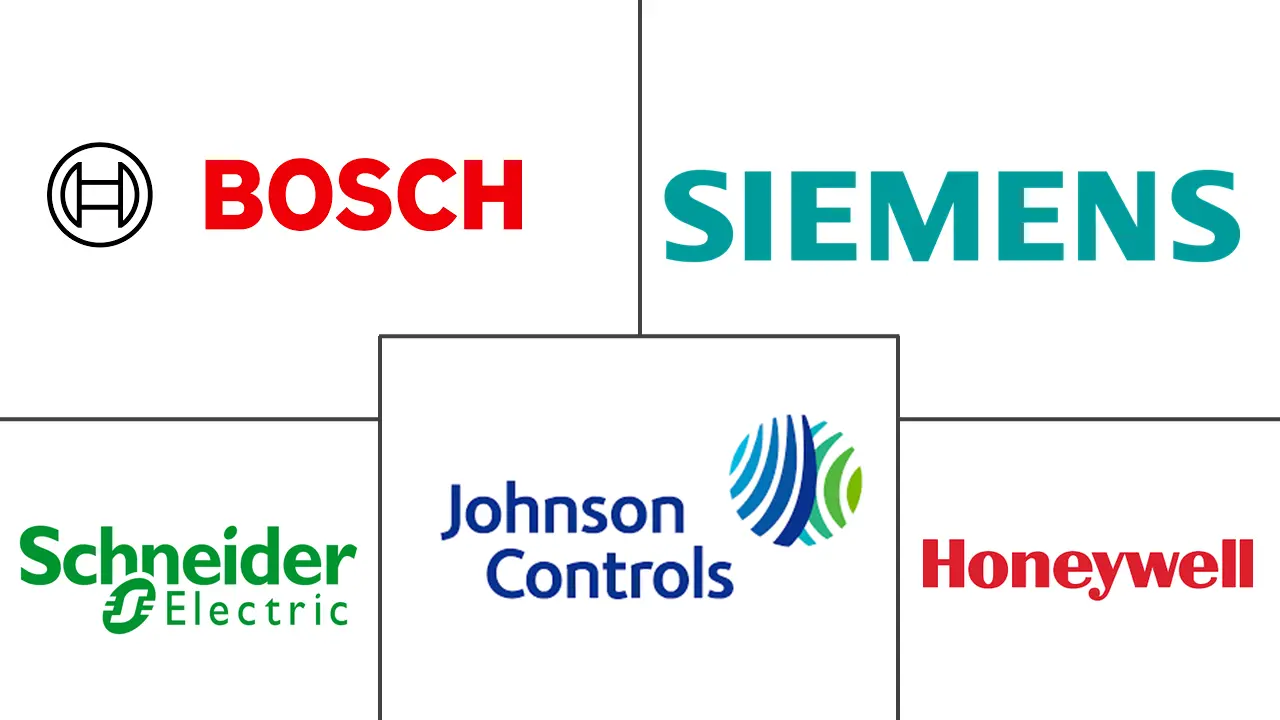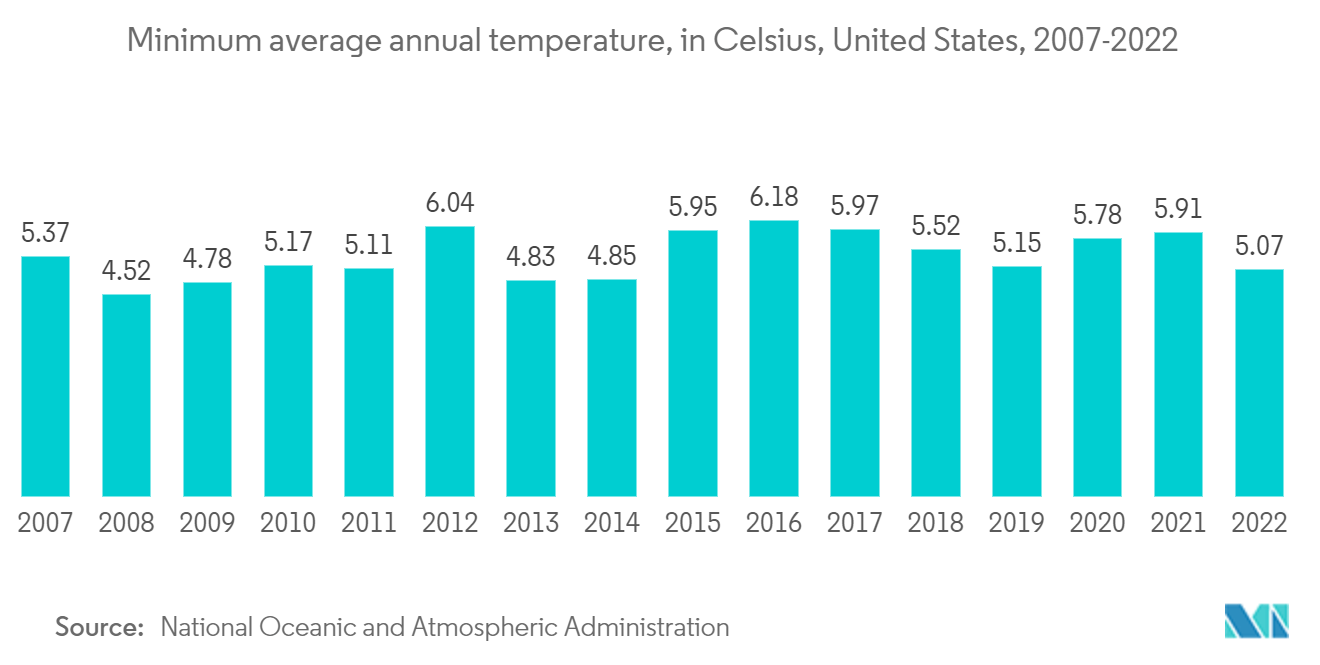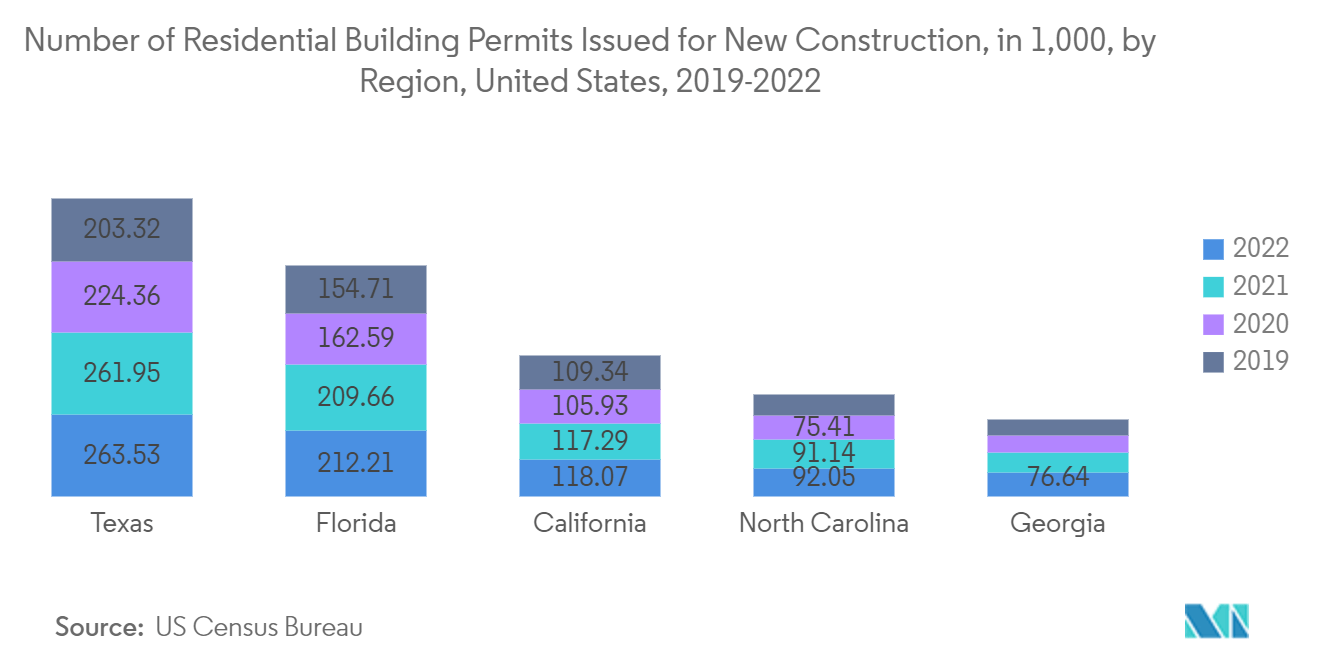US HVAC Field Device Market Size

| Study Period | 2019 - 2029 |
| Base Year For Estimation | 2023 |
| Market Size (2024) | USD 4.85 Billion |
| Market Size (2029) | USD 6.18 Billion |
| CAGR (2024 - 2029) | 5.00 % |
| Market Concentration | Medium |
Major Players
*Disclaimer: Major Players sorted in no particular order |
US HVAC Field Device Market Analysis
The US HVAC Field Device Market size is estimated at USD 4.85 billion in 2024, and is expected to reach USD 6.18 billion by 2029, growing at a CAGR of 5% during the forecast period (2024-2029).
The increasing construction activity, availability of high-efficiency systems, and extreme climatic conditions favor the system installation of HVAC equipment across the facilities in the country, thereby driving the growth of the HVAC field devices market. Additionally, the presence of prominent manufacturers, such as Siemens, Johnson Controls, and others, is complementing the North American market's growth in the future.
- HVAC in a commercial building usually consumes more energy than any other activity in the building. Energy standards and building codes have significantly steered the design of energy-efficient buildings over the past decade. For instance, the US Green Building Council's (USGBC) Leadership in Energy and Environmental Design Green Building Rating System has raised awareness of the need for building designs that use energy efficiently.
- As such, several states in the country have mandated the use of the LEED rating system for government buildings. Such initiatives indicate the importance of energy conservation in buildings. Since HVAC equipment is among the primary energy users in buildings, efficient air-handling units and air distribution systems can help save significant amounts of energy, reduce operating costs, and comply with widely used energy standards and building codes.
- As awareness and implementation of smart cities develop, consumers are expected to increase their spending on connected home appliances like thermostats and controllers. For instance, according to the Consumer Technology Association (CTA), connected home product revenue is increasing in the United States from 2018 to 2022. In 2020, connected home products in the United States were estimated to generate a revenue of USD 5.1 billion and reach USD 5.94 billion. This is making the vendors of HVAC solutions offer or enhance their product portfolios with the latest updates related to multi-device connectivity. Such developments are anticipated to offer lucrative opportunities for the HVAC field device market players in the United States.
- Heating, ventilation, and air conditioning (HVAC) are essential in the design of medium- to large industrial buildings and in regulating conditions within the manufacturing facility with respect to temperature and humidity by deploying an HVAC system for different manufacturing units. HVAC equipment is essential in the manufacturing sector to ensure the comfort and safety of workers as well as the proper functioning of manufacturing equipment.
- For instance, the food and beverage (F&B) industry, which comes under FMCG, requires extensive use of a hygienic, dust-free, pollutant-free environment and effective cooling to ensure optimal processing of highly perishable products with no damage to the final product. With the expanding manufacturing sector, various industrial infrastructures for producing highly vulnerable industries such as chemicals, pharmaceuticals, food, and beverages are also increasing.
- As a result, the market for refrigeration equipment is expanding rapidly due to factors including rising frozen food consumption and a growing population. According to the American Frozen Food Institute (AFFI), frozen food sales were expected to increase by 8.6% to reach USD 72.2 billion in 2022. The rising demand from the industrial sector in the United States is likely to boost the growth of the studied market.
- On the flip side, high energy consumption is expected to restrain the United States HVAC field devices market growth during the forecast period. Major entities in the commercial segment, such as retail complexes, hostels, entertainment centers, and others, typically rely on centralized HVAC systems for space conditioning.
- As per the International Energy Agency (IEA) and the US Department of Energy, around 25-35% of electricity consumption is due to HVAC systems. According to the same source, a large part (20%-60%) of this energy consumption is contributed by parasitic energy use (energy used to power fans and pumps used for transferring heating and cooling). Thus, centralized HVAC systems have burdened energy bills despite being more efficient (in terms of energy units' consumption per unit area of space conditioned) than unitary systems. However, rapid technological advancements are anticipated to offer a significant boost to the growth of the studied market.
- The pandemic significantly influenced the HVAC industry, as demand for the systems observed a significant drop during the initial months, owing to lockdown restrictions and businesses refraining from investing in new equipment. Due to the pandemic, many construction projects were halted across the world. The reduction in construction activities across the commercial, residential, and industrial sectors temporarily dampened the demand for HVAC systems, including air handling units. Moreover, amid the pandemic, labor shortages across HVAC manufacturing sectors delayed the production of HVAC equipment.
- However, the pandemic highlighted the importance of ventilation, which was a prominent factor driving the demand for HVAC equipment. The American Society of Heating, Refrigerating, and Air-Conditioning Engineers recommended strategies to mitigate COVID-19 transmission, eventually boosting demand across the United States. Hence, the future growth trajectory is projected to be firm.
US HVAC Field Device Market Trends
Damper Actuator HVAC Segment is Expected to Drive the Market's Growth
- In the United States, rapid HVAC system adoption has been observed in building automation systems (BASS), which is a significant component driving the overall damper HVAC actuator market growth.
- Furthermore, the adoption of BASS is increasing significantly due to advancements in wireless sensor network technology and wireless protocols. Moreover, the rise in the deployment of BASS in office buildings and large shopping complexes to improve the productivity of human systems augments the market's growth. HVAC systems in industries are among the most complicated systems available. Existing HVAC systems include various pieces of equipment, like actuators and sensors, that manage temperature, airflow, and other parameters.
- Improving energy efficiency is a major goal, with trends pointing to electrification and decarbonization as prominent options in the HVAC actuator sector. HVAC systems contribute significantly to carbon emissions in buildings, and there is rising recognition of the need to reduce these emissions. Electrification provides an appealing alternative to fossil fuels by enhancing efficiency and lowering emissions and consumer costs. The goal is to power HVAC systems with clean energy sources such as solar or wind. This method is both environmentally friendly and economically beneficial to building owners. HVAC actuators can replace traditional HVAC systems powered by propane, natural gas, or heating oil, thereby offering a sustainable option.
- Damper actuators are an essential component of commercial HVAC systems. These actuators assist in controlling airflow in various regions of the building and ensuring that the indoor environment is correctly managed. Damper actuators can be employed in various commercial structures, including non-uniform office areas, industrial halls, and gymnasiums.
- Prominent manufacturers, such as Belimo and Honeywell Buildings, provide a variety of damper actuators that are adapted to the needs of various types of commercial buildings. These include fire and smoke damper actuators that meet all commercial building codes in the United States.
- According to the US Census Bureau, following a noticeable drop in the value of commercial construction put in place during the 2008 recession, the value of commercial construction put in place recovered to pre-recession levels, reaching 115 billion US dollars in 2022. The most popular types of commercial development in the United States were warehouses and private offices. Spending on new private non-residential buildings in the United States exceeded USD 539 billion in 2022, exceeding the previous year's milestone. The recovery of the construction industry in the United States is likely to offer lucrative opportunities for the growth of the studied market.
- According to the National Oceanic and Atmospheric Administration, several of the hottest years on record have occurred in the last ten years. One degree of warming is noteworthy because it takes a tremendous amount of heat to warm the oceans, atmosphere, and land to this extent. The minimum average temperature in the contiguous United States in 2022 was 5.07 degrees Celsius. Such a huge rise in temperatures would create a demand for air conditioning systems, which would drive the need for damper actuator HVAC.

Residential Segment is Expected to Hold a Major Market Share
- The growth in residential construction activities, along with the rise in household disposable income, has increased the demand for HVAC field devices in the United States. According to the US Census Bureau, Texas and Florida had the highest number of residential building permits issued in 2022, totaling over 210,000. Such huge residential construction is expected to drive the market.
- Several developed countries have historically introduced energy regulations that introduced the idea of utilizing energy-efficient electronic equipment. For instance, in the United States, the Energy Policy and Conservation Act of 1975 first provided the U.S. Department of Energy (DOE) authority for developing, revising, and implementing minimum energy conservation standards for appliances and equipment. EPCA led DOE to amend energy conservation standards for specific equipment periodically, but only if the amendments are energy-saving, technologically feasible, and economically viable. Further, the National Appliance Energy Conservation Act of 1987 established minimum efficiency necessities for central air-conditioning and heat pump equipment sold in the United States, which went into effect in 1992, and further updates went into effect in 2006 and 2015.
- Due to the increasing U.S. Department of Energy's (DOE) interest in HVAC systems and how they work, they further started using the SEER (Seasonal Energy Efficiency Ratio) to regulate how residential systems operate under common conditions, especially related to energy consumption. Thus, like the evolving requirements for refrigerants, the following SEER standards are already in motion. For instance, the new standards effective in 2023 need a SEER of no less than 14 SEER for residential systems in the northern part of the United States as well as 15 SEER in the southern part of the United States, where cooling loads account for a larger share of home energy use.
- Further, the US Energy Information Administration's Residential Energy Consumption Survey estimates that over 76 million primarily occupied US homes (64% of the total) currently utilize central air-conditioning equipment. Around 13 million households (11%) use heat pumps for heating or cooling. By the end of 2023, new residential air-conditioning and air-source heat pump systems sold in the United States would be required to meet the new energy efficiency standards, fueling the growth of HVAC equipment. Such regulations are anticipated to boost the demand for energy-efficient HVAC systems across the United States, which is likely to enhance the demand for HVAC field devices.
- Moreover, according to the latest projections by the Energy Information Administration (EIA) released in October 2022, US consumers faced significantly higher heating costs due to a colder-than-average winter and high energy prices in the winter. Households that heated with oil or gas were expected to experience a cost increase of 27% and 28%, respectively, compared to 2021-2022. Such factors fueled the adoption of energy-efficient HVAC systems in the region.
- In the near future, heat pumps will likely take the lead as alternatives to fossil-fueled radiant systems in the residential market. If installed properly, geothermal heat pumps are a tried-and-true technology that performs incredibly well. However, the adoption of this technology has been restricted to high-end homes due to the cost of drilled ground loop wells (depending on geographic location). Due to a shift toward adopting energy-efficient products and an upsurge in consumer spending, the residential heat pump market in the United States is expected to continue to expand steadily. The ongoing progress toward a decarbonized economy, which legislative energy policies and incentives will support, will stimulate the business environment. A rise in the demand for flexibility and superior comfort in line with the rising refurbishment of existing buildings will boost innovations in the HVAC field devices market.

US HVAC Field Device Industry Overview
The United States HVAC field device market is moderately consolidated owing to the presence of large vendors like Siemens AG, Honeywell International Inc., etc. The key players are involved in various strategies, such as acquisitions and partnerships, to improve their market share and enhance their profitability in the market studied.
In December 2022, Continental announced solutions for user experience, automated driving, and software-defined driving to make driving safer, cleaner, and more comfortable using high-performance computers, vehicle sensors, and electronic control units. Furthermore, they provided intelligent power distribution and ensured the reliable execution of real-time vehicle functions such as audio, external sound, parking, HVAC, or suspension.
In July 2022, Archer Aviation Inc. signed a contract with Honeywell to deliver flight control actuation and thermal management technology. Honeywell's actuation technology was a key enabler of Archer's 12 tilt 6 layout, and Honeywell's thermal management technology would assist Archer in providing its passengers with an enhanced experience. Archer's production aircraft would fly in congested metropolitan areas, necessitating vital precision from the aircraft's flying controls and actuators. The actuators from Honeywell could take hundreds of microchanges and commands per second from fly-by-wire computers, allowing for precision navigation.
In July 2022, Sauter expanded its product line with the introduction of a new generation of IoT-capable actuators. The smart actuator allowed for autonomous or semi-autonomous heating, ventilation, and air conditioning control. Other advantages included easy installation and commissioning, cloud connectivity with an application library and remote access, and a smartphone app. Energy distribution relies heavily on valves and actuators. They are used in heating, ventilation, and room automation systems.
US HVAC Field Device Market Leaders
-
Siemens AG
-
Honeywell International Inc.
-
Robert Bosch GmbH
-
Johnson Controls International PLC
-
Schneider Electric
*Disclaimer: Major Players sorted in no particular order

US HVAC Field Device Market News
- March 2023 - The Master Group Announced a partnership with Ohio-based RSC to Expand its footprint in the US HVAC-R Industry. The Master Group and RSC's collaboration would enable companies to enhance their services, products, and value proposition to their customers. The collaboration reflects the companies' shared commitment to quality, customer satisfaction, and innovation, and the partnership is expected to provide a significant growth opportunity for the organizations.
- January 2023 - Air conditioning technologies providers LG Electronics USA unveiled new HVAC innovations for the residential builder market, encompassing energy-efficient heat pump technology, inverter technology, and solutions for indoor air quality at the 10th annual Design and Construction.
US HVAC Field Device Market Report - Table of Contents
1. INTRODUCTION
- 1.1 Study Assumptions and Market Definition
- 1.2 Scope of the Study
2. RESEARCH METHODOLOGY
3. EXECUTIVE SUMMARY
4. MARKET INSIGHTS
- 4.1 Market Overview
-
4.2 Industry Attractiveness - Porter's Five Forces Analysis
- 4.2.1 Bargaining Power of Suppliers
- 4.2.2 Bargaining Power of Buyers
- 4.2.3 Threat of New Entrants
- 4.2.4 Threat of Substitutes
- 4.2.5 Intensity of Competitive Rivalry
- 4.3 Technology Snapshot
- 4.4 Value Chain Analysis
- 4.5 Assessment of Impact of COVID-19 on the Market
5. MARKET DYNAMICS
-
5.1 Market Drivers
- 5.1.1 Increasing Demand for Energy-efficient Devices and Rising Trend of Smart Homes
- 5.1.2 Supportive Government Regulations
- 5.1.3 Emergence of IoT and Product Innovations
-
5.2 Market Restraints
- 5.2.1 High Initial Cost of Energy Efficient Systems
-
5.3 Market Opportunities
- 5.3.1 Increasing Urbanization and Industrialization
6. MARKET SEGMENTATION
-
6.1 By Type
- 6.1.1 Control Valve
- 6.1.2 Balancing Valve
- 6.1.3 PICV
- 6.1.4 Damper HVAC
- 6.1.5 Damper Actuator HVAC
-
6.2 By Sensors
- 6.2.1 Environmental Sensors
- 6.2.2 Multi Sensors
- 6.2.3 Air Quality Sensors
- 6.2.4 Occupancy & Lighting
- 6.2.5 Other Sensors
-
6.3 By End-user Industry
- 6.3.1 Commercial
- 6.3.2 Residential
- 6.3.3 Industrial
7. COMPETITIVE LANDSCAPE
-
7.1 Company Profiles
- 7.1.1 Siemens AG
- 7.1.2 Honeywell International Inc.
- 7.1.3 Johnson Controls International PLC
- 7.1.4 Robert Bosch GmbH
- 7.1.5 KMC Controls
- 7.1.6 Hansen Corporation
- 7.1.7 Continental AG
- 7.1.8 Denso Corporation
- 7.1.9 Schneider Electric
- 7.1.10 Belimo
- *List Not Exhaustive
8. INVESTMENT ANALYSIS
9. FUTURE OUTLOOK OF THE MARKET
** Subject To AvailablityUS HVAC Field Device Industry Segmentation
A field device controls local operations like opening and closing valves and breakers, collecting data from sensor systems, and monitoring the local environment for alarm conditions.
The United States HVAC field device market is segmented by type (control valve, balancing valve, PICV, damper HVAC, damper actuator HVAC), sensors (environmental sensors, multisensors, air quality sensors, occupancy and lighting sensors), and end-user industry (commercial, residential, and industrial). The market sizes and forecasts are provided in terms of value (USD) for all the above segments.
| By Type | Control Valve |
| Balancing Valve | |
| PICV | |
| Damper HVAC | |
| Damper Actuator HVAC | |
| By Sensors | Environmental Sensors |
| Multi Sensors | |
| Air Quality Sensors | |
| Occupancy & Lighting | |
| Other Sensors | |
| By End-user Industry | Commercial |
| Residential | |
| Industrial |
US HVAC Field Device Market Research Faqs
How big is the US HVAC Field Device Market?
The US HVAC Field Device Market size is expected to reach USD 4.85 billion in 2024 and grow at a CAGR of 5% to reach USD 6.18 billion by 2029.
What is the current US HVAC Field Device Market size?
In 2024, the US HVAC Field Device Market size is expected to reach USD 4.85 billion.
Who are the key players in US HVAC Field Device Market?
Siemens AG, Honeywell International Inc., Robert Bosch GmbH, Johnson Controls International PLC and Schneider Electric are the major companies operating in the US HVAC Field Device Market.
What years does this US HVAC Field Device Market cover, and what was the market size in 2023?
In 2023, the US HVAC Field Device Market size was estimated at USD 4.62 billion. The report covers the US HVAC Field Device Market historical market size for years: 2019, 2020, 2021, 2022 and 2023. The report also forecasts the US HVAC Field Device Market size for years: 2024, 2025, 2026, 2027, 2028 and 2029.
US HVAC Field Device Industry Report
Statistics for the 2024 US HVAC Field Device market share, size and revenue growth rate, created by Mordor Intelligence™ Industry Reports. US HVAC Field Device analysis includes a market forecast outlook to for 2024 to 2029 and historical overview. Get a sample of this industry analysis as a free report PDF download.



